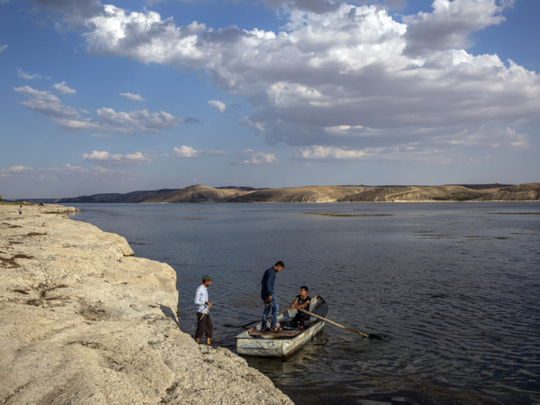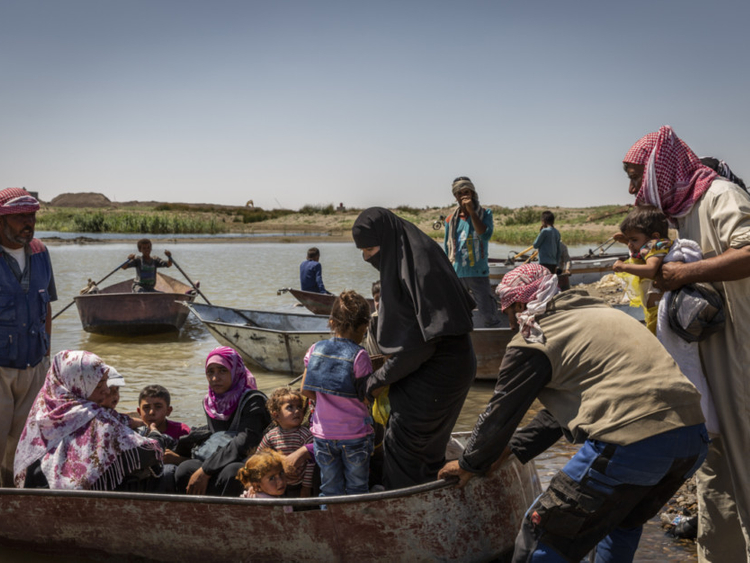
Zour Maghar, Syria - On the eastern bank of the Euphrates River, Kurdish militiamen aligned with US troops burrow into sandbagged positions and eye their foes across the water.
On the other side, Arab rebels backed by Turkey shoot at anyone who nears the river.
For millenniums, the Euphrates has given farmers in the village of Zour Maghar water to irrigate fields of wheat, eggplant and sunflowers. Generations of families have sprawled on its banks for picnics, the older children teaching the younger ones to swim.
But after seven years of war, the river that has fed life in Syria’s parched east has become a hostile front, separating warring sides as it travels north to south. Deprived of its water, families have fled Zour Maghar, abandoning their mud-brick homes and leaving their fields idle.
“The river was everything for us,” said Mohammad Bozan, 35, a farmer who can no longer work his waterfront land. “We used to live from the river and now we can’t.”
Syria’s war has taken hundreds of thousands of lives, displaced millions and left entire cities in smoking ruins. It has also ensnared the Euphrates, an arc of the Fertile Crescent that is considered a cradle of civilization.
On a recent trip along the river, we found a wasteland dotted with depopulated towns, gutted factories and civilians struggling to get by.
We mostly stayed on the east bank, an area out of Damascus’ hands that is effectively stateless and boxed in by hostile powers. The only way in was to cross the Tigris River from Iraq in a shaky, seatless motorboat.
As the regime of President Bashar Al Assad has focused its military power on defeating rebels in the north and south, the river has emerged as the collision point for the great powers and their local allies struggling for influence in the east.
On the eastern bank are mostly US-backed Kurdish-led militias. On the west, along the northern part of the river, are Turkish-backed rebels. Farther south are Syrian forces supported by Russia and Iran. Daesh still holds a pocket along the river near the border with Iraq.
For now, the division is holding because none of the other powers wants to confront the United States, which has about 2,000 soldiers on the eastern side and whose fighter jets control the skies there.
Most of the world has accepted that Al Assad will continue to rule Syria, but the standoff and shattered landscape along the Euphrates raise questions about whether he can ever stitch the whole country back together.
The immediate question is how long the United States will stay. President Donald Trump has said he wants to pull out the troops, who lead an international coalition against Daesh. If he does, the United States’ local allies fear the worst.
“The mere presence of the coalition in the region gives a message to the regime and to the Turks not to interfere: ‘This is where you stop,’” said Mohammad Kheir Shaikho, a member of the civil council in Manbij. “The withdrawal of the coalition forces, and at their head the American forces, would cause complete chaos in the area.”
The American security umbrella has allowed Manbij to become a relatively stable island in a war-torn country. It is a local economic hub, with a bustling market and about 200,000 new residents displaced from elsewhere.
But Turkey sees Syria’s Kurdish militia as a terrorist threat on its border and has threatened to attack it. The United States worries that a Turkish attack on Manbij would siphon off the Kurdish fighters from the battle against the Islamic State in the south. Thus the American patrols to keep the Turks at bay.
But as the battle against the Islamic State winds down, the Americans will have less reason to stay.
On the flat roof of a cinder-block farmhouse converted into a military base west of town, Kurdish militiamen pointed across a shallow valley at Turkish military positions and acknowledged that the Turks could storm the area quickly if they wanted. But they did not because of the American military base nearby: a few trailers surrounded by armoured vehicles, the Stars and Stripes flying overhead.
“If it weren’t for the Americans, there would be a disaster here,” said Ebrahim Shaikh Mohammad, a Kurdish militiaman.
Most of the territory held by the United States and its Kurdish allies was once ruled by Daesh, and the scars of the military campaign to defeat it run deep.
South of Manbij stands the Tabqa Dam, which the Soviets built in 1973, creating Syria’s largest body of water, Lake Assad, and generating power for much of the country.
Daesh ran the dam for years but blew up its turbines when they retreated.
It is now back at work, sort of. Its 350 employees work in buildings shattered by coalition air strikes that blew holes in walls and shook tiles off the floors. Inside the hydroelectric station, rows of charred circuit boxes set alight by Daesh sit below ceilings stained black from smoke.
But three of the dam’s turbines were whirring as water rushed through below, and a man with a blowtorch worked to repair a fourth. From eight damaged turbines, engineers had salvaged enough parts to rebuild three of them.
Since the Kurds took over the area, Turkey has reduced the amount of water it allows into Syria by more than half, limiting the generation of electricity, said Mohammad Tarboush, the dam’s supervisor.
The situation had never been so dire, he said, even when Daesh was in charge.
“They are boycotting us with water,” he said.
On the rocky banks of the Euphrates in the former capital of Daesh’s self-declared caliphate, boatmen yell to coax passengers onto rickety metal barges. Once they are filled with passengers, cars, motorcycles and trucks bearing everything from diapers to flatbread, the motors roar and belch black smoke as the men pilot their charges across the pale green water.
Raqqa was once a commercial centre for Syria’s breadbasket. Now, it is an orphaned city in ruins.
The military campaign that drove out the extremists in October left two-thirds of the city’s buildings damaged or destroyed, local officials said. Entire city blocks were erased and apartment buildings brought to the ground. Residents have returned to find walls and ceilings missing from their homes. Some even struggle to find their homes.
But the world powers who fought here, led by the United States, are staying out of reconstruction, so Raqqa’s residents are largely on their own.
All 32 bridges in the area were destroyed. The two major bridges spanning the Euphrates are impassable, cutting the city in half. One has a hole large enough for a tractor-trailer to fall through. Under the other, boys climb downed electrical cables to plunge in to the water below.
That has left only the barges to get people across.
Since the battle ended, the United States has put $13.7 million into Raqqa for water, electricity, rubble removal and other projects, in addition to $54 million to clear mines left by Daesh, according to the State Department.
But it is not rebuilding the city, which Ahmad Ebrahim, the city’s co-mayor, estimated would cost $5 billion.
He had no idea where that money would come from and worried that a lack of support would leave a vacuum that the Syrian regime or an extremist group like Daesh could exploit.
“As long as they give concrete aid, the people will belong to them,” he said.
Farther south, the road along the Euphrates is strewn with the remnants of an economy blown back decades by the war: a gutted sugar factory, an idled cotton mill, a train station littered with cars blown off their tracks.
The Syrian regime controls Deir Al Zor, the largest Syrian city on the Euphrates, but the bridge that connects it to its eastern suburbs across the river is destroyed.
The Kurds, their Arab allies and the United States hold the eastern side, with bases in the oil and gas fields to keep the Syrian regime and its Russian and Iranian allies from retaking them.
In some places, opposing bases face each other across the water, so close that soldiers can see each other’s flags and watch each other smoking cigarettes. At one crossing point, a local militiaman monitored the eastern side, while Syrian soldiers stood on the other, about 200 yards away, while residents rowed across in battered metal canoes.
“It’s like an international border,” said a woman on the Deir Al Zor civil council after stepping off a metal canoe that carried her from the regime side.
The woman, who spoke on condition of anonymity so that she could continue to visit her parents on the western side, said that most of the forces on the regime;s side were Syrian but that she sometimes saw Russians and Iranian-backed militiamen from Iraq and Afghanistan buying items in shops.
Incursions in either direction are rare. In February, a column of tanks carrying about 500 pro-regime forces, including Russian mercenaries, crossed the river in what appeared to be a push to seize an oil field. The United States repelled the raid, killing 200 to 300 of them.
Since then, all sides have largely accepted the river as the dividing line, an understanding likely to hold until the Americans leave.
The division was bad for Syria, the local councilwoman said, but she did not know how to end it.
“God willing, the sides will come together again,” she said.
NYT













